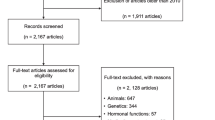Abstract
The high rate of implantation failure in humans following in vitro fertilization (IVF) has been attributed to a lack of production of immunosuppressive factors by cleaved embryos, rendering them vulnerable to maternal immune attack just before or around implantation. Systemic as well as blastocyst-secreted suppressor factors have been described and claimed to be responsible for successful pregnancy. Experimentally, we have screened in a double-blind fashion the suppressive activity of human embryo culture media (B2 Menezo system, France) in which zygotes after decoronization were individually cultured during 24 hr on lymphocyte proliferation as well as natural killer (NK) activity. Suppressive activity in media from cleaved and uncleaved ova did not differ significantly, and activity in media from transferred embryos was not correlated significantly with successful pregnancy. The implications of these data are discussed.
Similar content being viewed by others
References
Murray MK, Segerson EC, Hansen PJ, Bazer FW, Roberts MR: Suppression of lymphocyte activation by a high molecular weight glycoprotein released from preimplantation ovine and procine conceptuses. Am J Reprod Immunol 1987;14:38–45
Dey SK, Stechsulte DJ, Abdou NI: Modulation of the in vitro lymphocyte response by rabbit blastocysts. J Reprod Immunol 1981;3:141–145
Mayumi T, Bitoh S, Anan S, Hama T, Fujimoto S, Yamamoto H: Suppressor T lymphocyte induction by a factor from cultured mouse blastocysts. J Immunol 1987;134:404–408
Daya S, Lee S, Underwood J, Mowbray J, Craft I, Clark DA: Prediction of outcome following transfer of in vitro fertilised human embryos by measurement of embryo associated suppressor factor.In Reproductive Immunology, DA Clark, BA Croy (eds). Amsterdam, Elsevier, 1986, pp 277–289
Zorn JR, Boyer P, Guichard A: Never on Sunday: Programming for IVF-ET and GIFT. Lancet 1987;1:385–386
Ménézo Y: Milieu synthétique pour la survie et la maturation des gametes et pour la culture de l'oeuf fécondé. CR Hebd Seanc Acad Sci Paris D 1976;282:1967–1970
Goodwin JS, Webb DR: Regulation of the immune system by prostaglandins. Clin Immunol Immunopathol 1980; 15:106–122
Siiteri PK, Stites DP: Immunologic and endocrine interrelationships in pregnancy. Biol Reprod 1981;26:1–14
Dohr GA, Motter W, Leitinger S, Desoye G, Urdl W, Winter R, Wilders Truscini MM, Uchanska Ziegler U, Ziegler A: Lack of expression of histocompatibility leucocyte antigen Class I and Class II molecules on the human oocyte. J Immunol 1987;138:3766–3771
Ozato K, Yan YS, Orrison BM: Mouse histocompatibility class I gene expression begins at midsomite stage and is inducible in earlier stage embryos by interferon. Proc Natl Acad Sci 1985;82:2427–2431
Croy BA, Rossant J: Mouse embryonic cells become susceptible to CTL mediated lysis after midgestation. Cell Immunol 1987;104:355–365
Edelman P, Volante M, Frydman R, Testart J: Study of inhibition of natural killer (NK) activity by supernatants of in vitro fertilisation media.In Symposium INSERM 24. Human in Vitro Fertilisation. Actual Problems and Prospects, J. Testart, R Frydman (eds). Amsterdam, Elsevier, 1985, pp 213–218
Hill JA, Haimovici F, Anderson DJ: Products of activated lymphocytes and macrophages inhibit mouse embryo development in vitro. J Immunol 1987;139(7):2250–2255
Chaouat G, Kolb JP, Chaffaux S, Riviere M, Athanassakis I, Green D, Wegmann TG: The placenta and the survival of the fetal allograft.In Immunoregulation and Fetal Survival, TG Wegmann, TJ Gill III (eds). Oxford, Oxford University Press, 1987, pp 239–251
Armstrong DT, Chaouat G: Effects of lymphokines and immune complexes on murine placental cell growth in vitro (submitted for publication)
Wegmann T: Placental Immunotrophism. Maternal T cells enhance placental growth and function. Am J Reprod Immunol 1987;15:67–71
Author information
Authors and Affiliations
Rights and permissions
About this article
Cite this article
Armstrong, D.T., Chaouat, G., Guichard, A. et al. Lack of correlation of immunosuppressive activity secreted by human in vitro fertilized (IVF) ova with successful pregnancy. J Assist Reprod Genet 6, 15–21 (1989). https://doi.org/10.1007/BF01134576
Received:
Accepted:
Issue Date:
DOI: https://doi.org/10.1007/BF01134576




